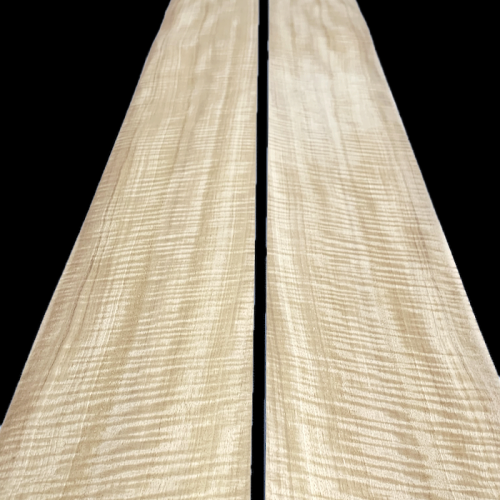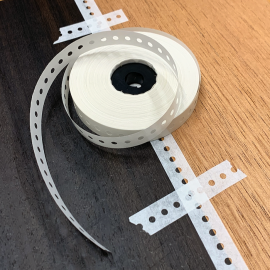
Curly Movingui Veneers 240 x 19 cm
Curly Movingui Veneers 240 x 19 cm
Genuine wood sliced-veneer sheets, in sequence.
Length: 240 cm.
Width: 19 cm.
Thickness: 0.55 mm.
Sold by the sheet.
These photos are taken from the veneer sheets you will receive.
Curly Movingui Veneers 240 x 19 cm
Genuine wood sliced-veneer sheets, in sequence.
Dimensions:
Length: 240 cm.
Width: 19 cm.
Thickness: 0.55 mm.
Measurement scaling:
The width is rounded to the covered centimeter. For example, 15.8 cm is given as 15 cm.
The length is rounded to 5 centimeters. For example, 257 cm is given as 255 cm.
Pictures:
These photos are taken from the veneer sheets you will receive.
While we strive to capture the color as accurately as possible, please note that the color may vary slightly from the photo. The screen on which the photos are viewed can also affect their appearance.
What is Movingui wood?
What are the shared names of Movingui?
Movingui, Nigerian satinwood, Ayan.
What is the botanical name of the Movingui?
Distemonanthus benthamianus.
What is the origin of the Movingui?
Movingui is native to West Africa, where it grows along the Gulf of Guinea, from Sierra Leone in the north to Gabon in the south.
It is widely distributed, although sparsely, in the humid tropical forest regions of West and Central Africa.
Its presence is particularly notable in Cameroon, Ghana, and Nigeria, but it is also found in other countries such as Benin, Congo, Equatorial Guinea, Guinea, Ivory Coast, Liberia, and Togo.
How to identify the Movingui?
The heartwood of Movingui exhibits a color that varies from yellow to yellowish-brown and tends to darken with age.
Its grain is generally straight or can be slightly to frequently interlocked, and sometimes even wavy.
The texture of this wood is typically medium to fine and uniform.
It possesses a natural luster that is generally good to moderate, sometimes described as slightly glossy.
A notable characteristic is the frequent presence of decorative figures in the heartwood, such as mottle, ribbon, and wave, which are particularly visible on the quarter-sawn surface.
On the other hand, the sapwood is narrow, straw-yellow in color, and quite distinctly demarcated from the heartwood.
What are the mechanical properties of Movingui?
Weight: Approximately 720 kg/m³ at 10-12% moisture content.
Janka Hardness: 5680 Newtons (for comparison, oak is 4980 N, and poplar is 1650 N).
Elasticity: 12.23 Gigapascals (for comparison, US maple is 12.62 GPa, and poplar is 9.75 GPa).
Crushing Strength: 61 Megapascals (for comparison, US maple is 109 MPa, and yew is 96 MPa).
What are the applications of Movingui?
Movingui has gained recognition as a substitute for Ceylon Lemon wood.
These attractive visual characteristics and a good luster contribute to Movingui's popularity for decorative veneers and furniture that requires a neat appearance.
Movingui is widely used to produce decorative sliced veneers and high-end furniture. It is also commonly used in interior design and the manufacture of decorative objects.
What are Wood Veneers?
Veneers are thin sheets of wood obtained by slicing or peeling.
Their surface has the appearance of planed wood without any finish or treatment. They are neither glued nor backed with any other material. This means that both sides of the sheets can be used.
Wood veneers are mainly used to cover less aesthetic substrates, such as plywood or particleboard, and to make furniture or wall panels.
Veneers are also used to create decorative objects such as lamps, jewelry, bookmarks, and more.
By assembling several sheets of veneer on top of each other, it is possible to manufacture objects requiring high mechanical resistance, such as skis, bicycle frames, or musical instruments.
The applications of veneer are as varied as they are multiple.
Since veneers are genuine wood, all wood finishing products, whether varnish, stain, or oil, are suitable. The choice of finish will depend on your personal preferences and the final use of the object.
The veneer offered here is a sliced sheet of uniform thickness, but the thickness might differ from one species to another. The standard thickness is around 0.6 mm.
Although the edges of the veneers have been cut roughly straight, the cut is not perfectly parallel. Some veneers may retain the natural taper of the tree, being slightly wider at the foot than at the top.
Some veneers may have a trace of a wavy edge (an edge following the tree's natural shape) on the sides. In this case, the dimensions indicated correspond to the minimum width of the veneer, as specified in the "Dimensions" paragraph.
How to use veneers?
How to cut the veneers?
Veneers can be easily cut with a utility knife.
For straight cuts, the best results are obtained with a veneer saw.
Use a fretsaw, scalpel, or veneer knife for curved cuts.
Always allow for a slightly larger veneer sheet than your intended surface. This will allow you to adjust the size after gluing for a clean finish.
A flush trimmer can also be used to trim the veneer after gluing.
When cutting with a utility knife or veneer knife, it is best to cut with the grain of the wood. To check this, run your finger along the edge of the sheet. The direction that feels smoothest is the ideal direction for cutting.
What is veneer splicing?
As the veneers have the width that nature gave us, you might need to cover an area wider than the veneers available.
Therefore, you need to splice the veneers by gluing or fixing them, side by side, with tape to obtain the desired width.
Trim the veneer's edges with a straight and smooth cut to realize good jointing.
Stick the veneers with tape (the blue one is a good choice.)
Usually, the veneers are spliced side by side, but to obtain a longer length, they can be done foot by foot.
The splicing must be done before gluing the veneers on the substrate.
What Glue to Use for Veneering?
Several types of gluing are possible.
Vinylic glue (PVA or PVB) is well adapted to porous substrates such as plywood, particleboard, or MDF. The veneers must be pressed with clamps over the entire surface at once.
Note: A technique using vinylic glue and an iron can also be used to glue veneers, but we strongly recommend choosing this technique only if other gluing solutions are impossible.
- Neoprene glue is applied to all surfaces, especially non-porous surfaces, using two coats of glue and marouflage.
- Animal glue, such as hide, sinew, or bone glue, is a product that must be cooked in a double boiler and used hot.
How to Sand Veneers?
Veneers and all our products are genuine wood and can be sanded according to thickness.
Please do not use a belt sander, regardless of the thickness of the veneer, as this could pierce it.
With a 0.6 mm veneer, lightly sand with 120 grit and then finish with 180 or 240 grit. With an orbital sander, 180 grit is already sufficient for most applications.
How to Finish a Veneer Realization?
All finishing products generally used for wood are suitable for finishing our products. For example, you can use a varnish, wax, paint, or oil.
However, ensure that the product you want to use is compatible with the final use of your creation.
More information:
Please look at our TUTORIALS; you might find some valuable tips.
Please contact us by email or phone for any additional information.
Data sheet
- Species
- Movingui
- Thickness group
- Standard
- Width group
- Standard width
- Grade
- Fiddled back
You might also like
 English
English







